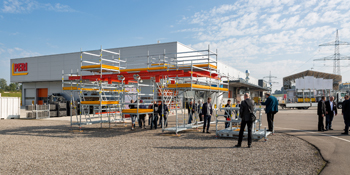Peri ups its scaffolding activities
01 December 2017
Peri, a leading German manufacturer of formwork and scaffolding systems, has recently opened its new global production hub for scaffolding, which will also serve the Middle Eastern markets with its Peri Up scaffold technology.
The state-of-the-art production facility, a primary plant for the Peri Up scaffolding technology, is located in the German town of Gunzburg that neighbours Weissenhorn, where Peri’s headquarters and main plant are based. The new plant is another important aspect of Peri’s growth strategy in the scaffolding market.
“We think in the long term and, with the addition of the Gunzburg facility, we have created the framework conditions for future company growth,” explains Leonhard Braig, managing director for product and technology at Peri.
He says Peri’s strategy for the future is one of pursuing significant and sustained growth for the scaffolding business, adding that one important segment with great potential is industrial scaffolding applications – for example, solutions for plant engineering in the process and energy technology sector. In addition, Peri Up scaffolding technology offers a wide range of applications and customer benefits for the entire building trade.
According to Wolfgang Goggelmann, general manager of the Günzburg plant, the scaffolding plant is complete with cutting-edge technology, where efficient processes and great production expertise has been realised. “In the worldwide Peri production network, this facility will assume the technological leadership of the scaffolding division. It is a very exciting challenge for me to support this,” he says.
 |
Some products on display within the facility grounds. |
At Gunzburg, Phase One expansion has been completed while excavation work for Phase Two expansion – which will include hot-dip galvanising operations and metal production – is scheduled to start at the year-end. This investment is worth hundreds of millions of dollars.
Braig points out that a cutting-edge factory layout, efficient plant engineering and optimal processes play a decisive role in the new manufacturing facility and the plant in Gunzburg is one of the most efficient of its kind.
He says: “At the production plant in Gunzburg, state-of-the-art welding processes and fully automated welding robots ensure a consistently high quality of the welds. Also, the facility is equipped with highly accurate measuring technology thus guaranteeing consistently high production results.”
In addition, an important contribution to the efficiency of the plant is realised by aligning the entire production process according to so-called value streams that optimise all material and communication flows in the factory.
Peri’s first scaffolding system was the Peri Up T 72 Frame Scaffold in 1998, followed by other products for various applications in scaffolding technology. Since then, the company has succeeded in acquiring several new customers. In addition to construction companies, which use scaffolding among other things as shoring, Peri has also provided solutions for the scaffolding sector. With additional products and system components, this division has increasingly developed into Peri’s second business mainstay alongside its formwork technology.
Braig says Peri scaffolding technology clearly stands out among competing systems in the market, especially in terms of safety, where they make a very convincing case and are finding increasing recognition in the worldwide market under the Peri Up name.
With the Peri Up Flex Modular Scaffolding, Peri has been gaining more and more users in the plant engineering sector, which is another target group. In April 2016, Peri showcased the new Peri Up Easy Façade Scaffolding at the world’s leading trade fair bauma in Munich. With the current product portfolio, Peri can easily cover all requirements of professional scaffolding operations.
With a turnover of more than €1.3 billion ($1.53 billion) in 2016, Peri is one of the largest international manufacturers and suppliers of formwork and scaffolding systems. It has a global workforce of around 8,100 employees, more than 70 subsidiaries and over 130 efficient storage facilities.
- New Morning with RAK Ceramics
- ‘Cutting’ down waste
- Guardian to shine on tallest tower
- Peri ups its scaffolding activities
- Merc-Benz rides high on success
- Tech Group opens fifth readymix plant in UAE



